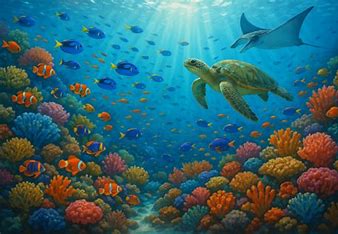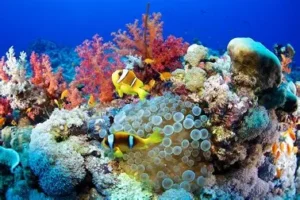
Shenali Dawson
Beautiful coral reefs lie beneath the sparkling surfaces of sapphire-blue seas. Although they only take up a tiny amount of space in the world’s oceans, coral reefs contain a large amount of sea creatures and are home to billions of sea creatures and plants. Coral reefs are one of the most precious eco systems in the world, but they are in great danger of disappearing forever.
Coral reefs are ocean habitats that are made by creatures that live inside them. Tiny coral animals called polyps live together in huge numbers known as colonies. They can grow for thousands of years. Its not only coral polyps that help a reef grow. Polyps provide the framework of a reef, but other living things add to the structure. Some marine organisms, such as sponges and sea cucumbers have a hard substance called silicon in their skeletons. When they die their skeletons add to the coral reef.

Polyps have a special relationship with tiny creatures called zooxanthellae. These are plant like algae that live inside a polyp’s body, providing it with some of the food it needs to grow. In return the polyps provide the algae with a safe place to live. Zooxanthellae need sunlight to survive, so they live inside a polyp’s tentacles, where light can reach them. Soft bodied corals protect themselves by growing hard cases. These cases are made from Calcium carbonate, a tough substance that turns into stone over time. Each case is cup shaped and the polyp grows inside it. As new polyps develop. They build on top of one another- this is how the reef grows.
Adult polyps are stuck in stony cups, but young polyps can swim. A young polyp is called a planula and it is covered in tiny hairs that help it move through the water. It may float around for days or weeks until it finds a hard surface to attach itself to, and grow into an adult. There are two main types of coral– hard coral and soft coral. Hard coral polyps are reef-builders – they use calcium carbonate to build strong structures around themselves. Soft corals are bendy and often live alongside their stony cousins.

Dirty water is no good to coral polyps. They prefer clear water, without the tiny particles of dirt, mud or sand that prevent light from reaching the seabed. Reefs don’t grow near river mouths, or in areas where dirt is washed from the land into the sea. Polyps are even fussy about the amount of salt dissolved in the ocean water around them. Sunlight cannot pass through water as easily as it can pass through air. As zooxanthellae need light, their coral polyps only grow in water with a maximum depth of around 11m – although this varies depending on how clean the water is. This explains why warm water coral reefs grow near the land where the water is shallow.
There are three main types of coral reef. Fringing reefs are the most common. They grow on the edges of land that are underwater, often with little or no gap in between the reef and dry land. Barrier reefs also grow where land meets the ocean, but they are separated from the land by a stretch of water, called a lagoon. Atolls are circular reefs with a lagoon in the centre.
Most corals grow on the sides of the reef that face the sea and wind. This area is known as the fore reef and it is warmed by ocean currents. The corals here grow upwards and outwards, building up layers over thousands of years. Below the fore reef is a collection of old coral material that has broken off and fallen to the seafloor. The highest part of the fore reef is the crest – the polyps that live here must be able to survive strong waves and winds. The Great Barrier Reef, on the north-east coast of Australia, is possibly the largest structure ever built by animals. It covers an area of the Coral Sea that extends for more than 2000km and it took around 18 million years for the reef to grow to this enormous size.
 The Great Barrier Reef was not studied by scientists until the 18th century. British explorer James Cook (1728–1779) sailed his ship, HMS Endeavour, onto the reef in June 1770, and his crew had to spend six weeks repairing the damage to their craft. Ever since, explorers and scientists have been studying the structure of the reef and its wildlife.
The Great Barrier Reef was not studied by scientists until the 18th century. British explorer James Cook (1728–1779) sailed his ship, HMS Endeavour, onto the reef in June 1770, and his crew had to spend six weeks repairing the damage to their craft. Ever since, explorers and scientists have been studying the structure of the reef and its wildlife.
In 1975,the Great Barrier Reef Marine Park was set up to protect the reef. The area is home to an enormous variety of living things – there are 5000 species of molluscs, 1500 species of fish, 400 species of coral, 200 species of birds, 125 species of sharks, rays and skates, 30 species of whales, dolphins and porpoises, 14 species of sea snakes and six species of marine turtles! Native people and nearby islanders from the Torres Strait have fished in the Coral Sea for more than 60,000 years. They are known as the Traditional Owners of the Great Barrier Reef. The areas of the reef that they used in the practice of their ancient lifestyles are called the sea country. Traditional Owners work to preserve their ancient connection to the Great Barrier Reef.
Exploring a reef is a magical experience. Bathed in warm, blue water, a diver can swim among thousands of fish that dart around the coral. As schools of small, silvery fish flash past, smaller groups of predator fish follow – fast and alert in the chase. Coral reefs are fragile ecosystems that are under threat from humans. When they are stressed, coral polyps lose their zooxanthellae, and die. Once the polyps have died the coral structure that is left appears white, and is described as ‘bleached’. Catching and killing fish adds to the bleaching of coral reefs. In some parts of the world, fishermen use destructive methods of fishing. They drop bombs in the water, which explode and kill whole schools of fish, turning coral to crumbs. They also use chemicals, such as cyanide, to kill or stun fish.
Scientists believe many coral reefs can be saved if they are protected now. Pollution is one of the biggest coral killers, and removing it could have an immediate effect on reefs’ survival. This will give us more time to tackle the big problem of global warming, which will take many years.
So we need to protect corals, It’s important to marine life and eco system.